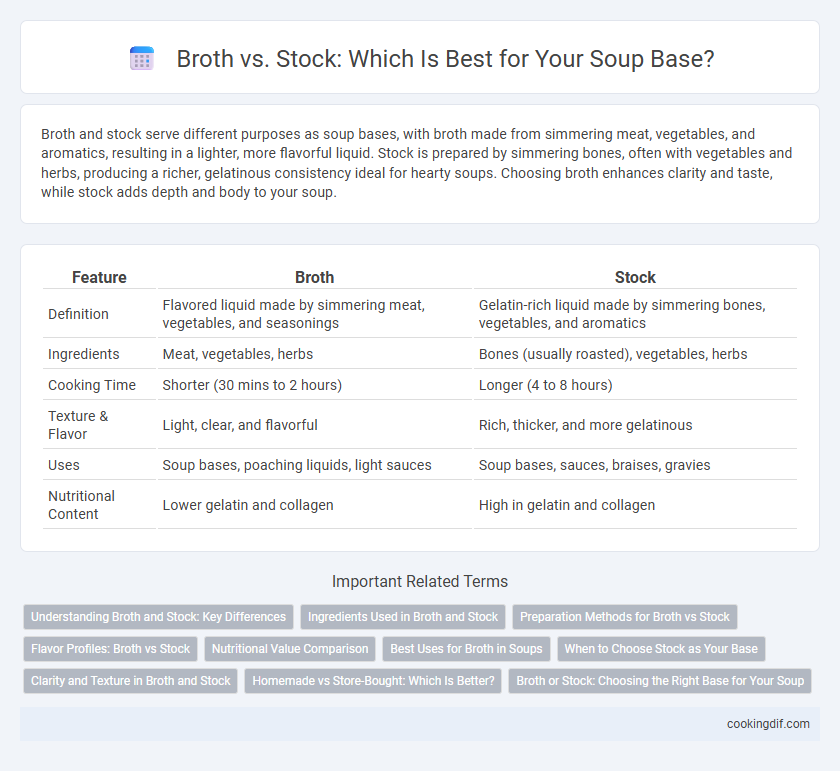Broth and stock serve different purposes as soup bases, with broth made from simmering meat, vegetables, and aromatics, resulting in a lighter, more flavorful liquid. Stock is prepared by simmering bones, often with vegetables and herbs, producing a richer, gelatinous consistency ideal for hearty soups. Choosing broth enhances clarity and taste, while stock adds depth and body to your soup.
Table of Comparison
| Feature | Broth | Stock |
|---|---|---|
| Definition | Flavored liquid made by simmering meat, vegetables, and seasonings | Gelatin-rich liquid made by simmering bones, vegetables, and aromatics |
| Ingredients | Meat, vegetables, herbs | Bones (usually roasted), vegetables, herbs |
| Cooking Time | Shorter (30 mins to 2 hours) | Longer (4 to 8 hours) |
| Texture & Flavor | Light, clear, and flavorful | Rich, thicker, and more gelatinous |
| Uses | Soup bases, poaching liquids, light sauces | Soup bases, sauces, braises, gravies |
| Nutritional Content | Lower gelatin and collagen | High in gelatin and collagen |
Understanding Broth and Stock: Key Differences
Broth is a flavorful liquid made by simmering meat, vegetables, and seasonings, typically ready to eat on its own, while stock is made primarily from bones and connective tissue, resulting in a richer, gelatinous texture ideal for soups and sauces. Broth often contains added seasonings and has a lighter consistency, whereas stock is more concentrated and unseasoned, providing a robust foundation for culinary dishes. Both broth and stock serve as fundamental soup bases, but selecting the right one depends on the desired depth of flavor and texture in the final recipe.
Ingredients Used in Broth and Stock
Broth is made primarily from meat, vegetables, and seasonings, simmered for a shorter time to extract flavor, resulting in a lighter, more flavorful liquid. Stock is prepared by simmering bones, often roasted, along with aromatic vegetables and herbs, producing a richer, gelatinous texture due to the collagen released from bones. The choice of ingredients influences the depth, mouthfeel, and nutritional content of the soup base.
Preparation Methods for Broth vs Stock
Broth is prepared by simmering meat, vegetables, and aromatics for a shorter time, typically 45 minutes to 2 hours, resulting in a lighter, more flavorful liquid. Stock requires longer cooking, often 4 to 6 hours or more, using bones and connective tissues to extract gelatin and create a richer, thicker base. The key difference lies in the ingredients and cooking duration, where broth emphasizes meat flavor and clarity, while stock prioritizes body and depth from bones.
Flavor Profiles: Broth vs Stock
Broth has a lighter, more delicate flavor profile derived from simmering meat, vegetables, and aromatics, making it ideal for soups that require a subtle base. Stock offers a richer, deeper taste due to prolonged cooking of bones and connective tissues, releasing gelatin that adds body and complexity to the soup. Choosing between broth and stock influences the final dish's depth, mouthfeel, and intensity of flavor.
Nutritional Value Comparison
Broth typically contains less collagen and gelatin than stock, resulting in a lighter texture and slightly lower protein content, making it easier to digest and suitable for clear soups. Stock, simmered with bones and connective tissues, is rich in minerals like calcium, magnesium, and phosphorus, along with higher amounts of collagen, supporting joint health and improved gut function. Both broth and stock provide essential nutrients, but stock offers a more concentrated source of vitamins and minerals beneficial for overall nutritional intake.
Best Uses for Broth in Soups
Broth serves as a flavorful, lighter soup base ideal for clear soups, consommes, and vegetable-based recipes where a delicate taste is preferred. Its seasoning and subtle aroma enhance soups like chicken noodle or miso without overpowering other ingredients. Broth's clarity and balanced flavor profile make it perfect for quick-cooking soups and recipes requiring a clean, refined liquid foundation.
When to Choose Stock as Your Base
Stock is preferred as a soup base when a rich, deep flavor is required, especially for recipes needing long simmering times to extract gelatin from bones. It provides a thicker, more gelatinous texture due to the collagen released during cooking, enhancing mouthfeel and body in soups like French onion or hearty vegetable stews. Choose stock over broth for dishes that benefit from a robust and savory foundation without added seasoning, allowing more control over the final taste.
Clarity and Texture in Broth and Stock
Broth offers a clear, light texture ideal for delicate soups, while stock provides a richer, gelatinous consistency that enhances body and mouthfeel. Broth is typically simmered for a shorter time with meat and vegetables, resulting in a translucent liquid, whereas stock is cooked longer with bones, extracting collagen that thickens and adds depth. The choice between broth and stock directly affects soup clarity and texture, influencing the final culinary experience.
Homemade vs Store-Bought: Which Is Better?
Homemade broth and stock offer richer flavors and customizable nutrient profiles compared to store-bought options, which often contain preservatives and excess sodium. Broth, made primarily from meat and simmered for a shorter time, provides a lighter taste, whereas stock, simmered longer with bones, yields a gelatin-rich, robust base ideal for hearty soups. Choosing homemade versions enhances control over ingredients and freshness, making them superior for health-conscious and culinary-focused soup enthusiasts.
Broth or Stock: Choosing the Right Base for Your Soup
Broth, made from simmering meat, vegetables, and aromatics, offers a lighter, more clear flavor ideal for delicate soups. Stock, simmered primarily with bones and connective tissues, provides a richer, gelatinous texture perfect for hearty, robust soups. Selecting broth or stock depends on the desired soup consistency and flavor intensity.
Broth vs Stock for soup base Infographic

 cookingdif.com
cookingdif.com